
Dapedium is an extinct genus of primitive neopterygian ray-finned fish. The first-described finding was an example of D. politum, found in the Lower Lias of Lyme Regis, on the Jurassic Coast of England. Dapedium lived in the late Triassic and Jurassic periods.

Pycnodus is an extinct genus of ray-finned fish from the Eocene period. It is wastebasket taxon, although many fossils from Jurassic or Cretaceous are assigned to this genus, only Eocene species, P. apodus is valid. As its name suggests, it is the type genus of Pycnodontiformes.
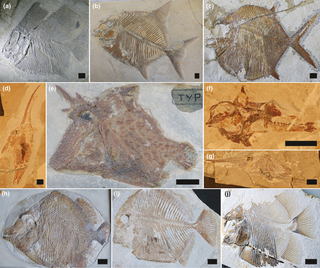
Pycnodontiformes is an extinct order of primarily marine bony fish. The group first appeared during the Late Triassic and disappeared during the Eocene. The group has been found in rock formations in Africa, Asia, Europe, North and South America. They were small to middle-sized fish, generally with laterally-compressed deep bodies, some with almost circular outlines, adapted for manuverability in reef-like environments, though the group was morphologically diverse. Most, but not all members of the groups had jaws with round and flattened teeth, well adapted to crush food items (durophagy), such as echinoderms, crustaceans and molluscs. Some pyncodontiformes developed piranha like teeth used for eating flesh. Most species inhabited shallow marine reef environments, while a handful of species lived in freshwater or brackish conditions. While rare during the Triassic and Early-Middle Jurassic, Pycnodontiformes became abundant and diverse during the Late Jurassic, exhibiting a high but relatively static diversity during the Early Cretaceous. At the beginning of the Late Cretaceous they reached their apex of morphological and species diversity, after which they began to gradually decline, with a more sudden decline at the end of the Cretaceous due to the collapse of reef ecosystems, finally becoming extinct during the Eocene. They are considered to belong to the Neopterygii, but their relationship to other members of that group is uncertain.
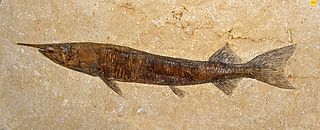
Vinctifer is an extinct genus of prehistoric bony fish erected by David Starr Jordan in 1919.
Luisiella is an extinct genus of prehistoric bony fish that lived during the Kimmeridgian stage of the Late Jurassic epoch. Fossils of the genus have been found in either the Cañadón Calcáreo Formation or Cañadón Asfalto Formation in Chubut Province, Argentina.
Aetheolepis is an extinct genus of ray-finned fish which lived in freshwater environments in what is now Western Australia and New South Wales during the Jurassic period. It contains one species, A. mirabilis. Aetheolepis was previously thought to be an archaeomaenid, until a 2016 study instead recovered it as a member of the family Dapediidae. Like other dapediids, it had a deep, discoid-shaped body. Fossils of A. mirabilis have been found in the Talbragar River fossil beds of New South Wales and the Colalura Sandstone of Western Australia. It was named by Arthur Smith Woodward in 1865 along with other Talbragar fish.
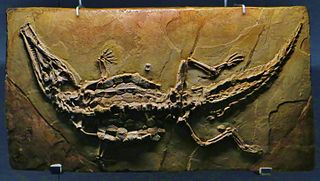
Crocodilaemus is an extinct genus of pholidosaurid mesoeucrocodylian. Fossils have been found from the Cerin Lagerstätte of eastern France and are of late Kimmeridgian age. The depositional environment in Cerin at the time is thought to have been the bottom of a lagoon that was enclosed by an emergent reef complex, evidence of the shallow tropical sea that covered much of western Europe during the Jurassic period.
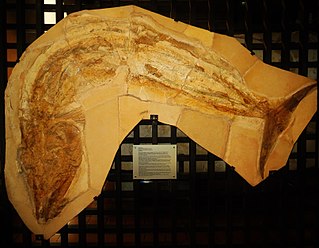
Asthenocormus is an extinct genus of pachycormiform ray-finned fish. A member of the edentulous suspension feeding clade within the Pachycormiformes, fossils have been found in the Upper Jurassic plattenkalks of Bavaria, Germany.

Anaethalion is an extinct genus of prehistoric ray-finned fish.
Coelodus is an extinct genus of fish in the family Pycnodontidae from the Late Jurassic to early Paleocene (Danian). Fossils of the genus have been found in:

Coccolepis is an extinct genus of prehistoric ray-finned fish in the family Coccolepididae. Originally including most species within the family, it is now restricted to two species from the Late Jurassic Solnhofen Limestone of Germany. The holotype of C. bucklandi, designated and described by Louis Agassiz, was thought to be lost but was later rediscovered in Neuchâtel.
Proleptolepis is an extinct genus of ray-finned fish belonging to the family Leptolepidae.

Saurorhynchus is an extinct genus of carnivorous bony fish that lived during the Early and Middle Jurassic epochs. Fossils have been found in Europe and North America (Canada). It is commonly found in pelagic and lagoonal deposits, but mostly marine. Largest specimens can grow up to 1.9 metres (6.2 ft).

Pycnodontidae is an extinct family of ray-finned fishes, ranging from the Triassic period until the Eocene.
This list of fossil fishes described in 2016 is a list of new taxa of jawless vertebrates, placoderms, acanthodians, fossil cartilaginous fishes, bony fishes and other fishes of every kind that have been described during the year 2016, as well as other significant discoveries and events related to paleontology of fishes that occurred in the year 2016. The list only includes taxa at the level of genus or species.

Orthogonikleithrus is a genus of extinct ray-finned fish that lived during the Late Jurassic period. It lived in lagoonal and restricted shallow subtidal zones.

Piranhamesodon pinnatomus is a pycnodontiform fish from the Late Jurassic. It was described from the Plattenkalk deposits of the Solnhofen Formation, in Bavaria, Germany. It is notable for having sharp, serrated teeth highly reminiscent of a piranha, a highly unusual trait as most other species in the order Pycnodontiformes were shellfish eaters with flat, crushing teeth. It is also the oldest known bony fish with this trait. This unusual combination is reflected in its genus name, which is a combination of piranha and the frequent pycnodontiform genus suffix Mesodon. Fossils of other fish found in the same area have torn fins possibly attributable to this species.

The paleontological site of Cerin is a fossil deposit of the Jura Mountains located in Cerin, a hamlet belonging to the commune of Marchamp in the department of Ain. The site is internationally known for its surprising diversity.
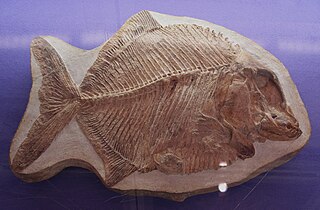
Neoproscinetes is a genus of extinct pycnodontid fish from the Cretaceous Santana Formation of Brazil. Fossils of this species have also been discovered in the Riachuelo Formation.

Thiollierepycnodus is an extinct genus of pycnodontid fish from the Jurassic of France and Germany. The animal was originally assigned to the genus Pycnodus, but it was given its own genus in 2020. Thiollierepycnodus was 25 cm long, with a laterally flat body and comparatively large fins, indicating that it was a reef fish of considerable manoeuvrability. Its durophagous dentition strongly suggests a diet of hard-shelled organisms. It contains a single species, Thiollierepycnodus wagneri.
















